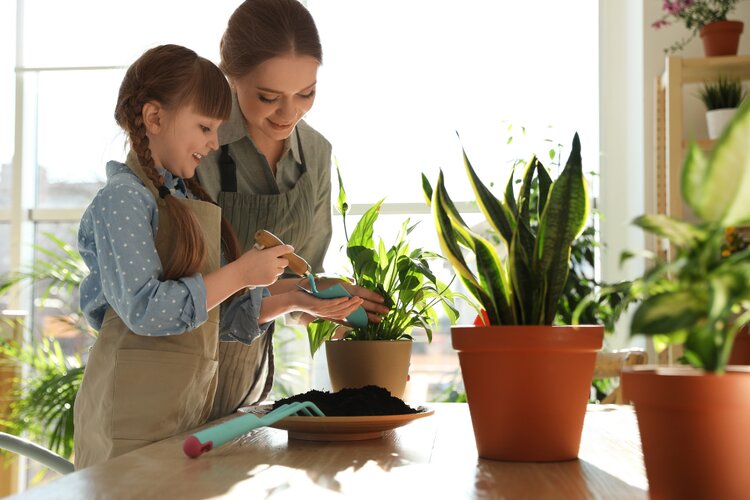
Nov 15, 2021
How to Take Care of Indoor Plants: 5 Tips to Keep Them Happy
Taking care of your indoor plants can be tricky, especially if you’re new to the game. Indoor plants can have a range of positive effects on your home, with the vibrant colours adding a sense of calmness and fantastic health benefits protecting your family against harmful toxins in the air.
From ferns to cacti to flowering plants, there are variations in how you can best care for your plant babies, but all of them have similar basic needs - so here are our 5 favourite care tips you can use to keep your indoor plants happy, healthy and thriving.
1. Water Your Plants as Needed
We all know plants need to be watered, but finding the right balance between giving your plant too much or too little water is something that many plant owners face. Each type of plant demands a different amount of water and generally speaking, plants with lush, thick leaves need more than those with leathery or waxy leaves.
Watering your plants too often can damage their roots and stunt their growth, whereas not enough water can leave you with a dry plant clinging on for dear life. So you’re better off watering your plants on an as-needed basis instead of a calendar schedule - but if you’re really unsure about how much water is enough, keeping them on the drier side is a safer option.
CARE TIPS:
- Place a finger into the soil about 1 to 3cm deep. If your finger comes back dry, it’s time to water your plants, but if it’s still moist, hold off for a few days and check again then.
- Use room temperature (20 degrees Celsius) water for your plants as hot and cold water can damage the roots, affecting growth.
- Make sure your pots have good drainage, to prevent any water from leaking and making a mess on your carpet.
2. Find Good Lighting Conditions
Plant real estate is all about location, location, location! One of the concerns with indoor plants is their exposure, or lack thereof, to sunlight. Indoor plants need sunlight to photosynthesise and make food for themselves, using the carbon dioxide we exhale and turning it into the oxygen we inhale.
While your plant may look nice on the windowsill - the quality, light intensity, and time duration of exposure are factors you need to consider before deciding where to place them. A good rule of thumb to follow is that your indoor plants need a minimum of 5-6 hours of sunlight, if not more.
CARE TIPS:
- Choose a well-lit room with enough light to thrive, instead of placing them under direct sunlight.
- Avoid frequently moving your plants, as it takes them time to adapt to their new surroundings - especially if there is a significant temperature difference.
- If you intend to move your plants, get them to slowly adapt to the new spot by placing them there for an hour a day, and then gradually increase it over time.
3. Fertilise Your Plants
With your indoor plants not being exposed to the natural elements of the outdoors, using a fertiliser gives them the nutrients they need. Most houseplants need an equal 10-10-10 mix of n-p-k (Nitrogen, Phosphorous, Potassium) elements that help promote their growth. Each of these elements has its strengths - with N promoting healthy foliage growth, P boosting a strong root system and K supporting healthier, bigger blooms.
When it comes to fertilising, it’s important to get it right. Over-fertilising your plant can burn its roots, while under-fertilising it can restrict their growth - so talk to an expert at your local garden centre to find out how much fertiliser is right for each plant.
CARE TIP:
- Most indoor plants have a growth spurt in the warmer months of spring and summer, so it’s best to fertilise your plants during this time.
4. Repot Your Plants
Repotting your plants stops the roots from outgrowing the pot and keeps plants healthy, plus choosing a pot that fits in with the design and style of your home will help your plants really make a statement. So if you do see the roots shooting out of the pot, it’s a clear sign to repot them, and the best time to do so is typically during spring and summer.
CARE TIP:
- If your plants have entirely outgrown their current pot, you can simply repot it in a larger container with fresh soil. But if you want to keep it in the same pot, trim down the roots and replant it with new soil.
5. Remove Dust From Your Plants
Like most things in your home, your indoor plants will attract dust. Your plants’ leaves will accumulate a layer of dust that takes away their natural beauty and clogs up their pores - making it harder for them to grow. Removing the dust adds a new lease of life, brightening up your plants’ appearance and allowing them to soak up more light.
CARE TIPS:
- Use room temperature water (20 degrees Celsius) to wash the dust off their leaves.
- For plants with hairy leaves, use a soft brush to brush off any dust.
- As for plants that have smooth leaves, grab a cloth and gently wipe down the leaves.
With these 5 simple tips to keep your indoor plants happy, your leafy green friends will thank you for it and grow beautifully into lush living decor in your home. Indoor gardening can be a rather messy job - so if you end up making a mess on your carpets, vacuum the loose dirt before using Rug Doctor’s Spot Remover to remove the stubborn stains and get your carpet looking as good as new.
If you’re after more information on how to remove those stubborn stains and getting your carpet looking fresh, download our Ultimate Stain Guide today!